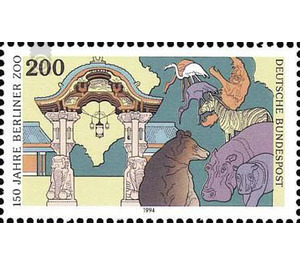block stamp: 150th birthday of Carl Hagenbeck;150 years of the Berlin Zoo - Germany / Federal Republic of Germany 1994 - 200 Pfennig
Theme: Calender
| Country | Germany / Federal Republic of Germany |
| Issue Date | 1994 |
| Face Value | 200.00 |
| Color | multi-colored |
| Perforation | K 14 |
| Printing Type | Multicolor offset printing |
| Stamp Type | Postage stamp |
| Item Type | Stamp |
| Chronological Issue Number | 1608 |
| Chronological Chapter | GER-BRD |
| SID | 131758 |
| In 17 Wishlists | |
The Berlin Zoo and its approximately 13,000 animals in nearly 2,000 species are the target of more than 3 million visitors each year. Here you will find amusing nature education and relaxation. The zoo also sees itself as a scientific institution in which, in addition to research, a significant contribution is made to the preservation of the animal world threatened by extinction worldwide. The founding of the Zoological Garden "near Berlin" goes back to Prof. Martin Hinrich Lichtenstein, the leading zoologist at the time. Together with Alexander von Humboldt and the great garden designer Peter Joseph Lenné, he was able to win the support of the Prussian court for his initiative: King Frederick William IV even contributed the animals as well as transportable housing from his ancestral menagerie on the Peacock Island as a gift. On August 1, 1844, the opening took place - but without much attention by the otherwise all new so open-minded Berlin. The culprit was the pistol attack on the king a few days earlier, which attracted all public interest. At the beginning, the Berliners hardly accepted the zoo, because it was j.w.d. ("Far out") in front of the city. The situation did not change until the 1970s, when the city and the zoo boomed after the German-French War. Director Dr. Bodinus took advantage of this auspicious time to expand the zoo with numerous exotic-style hothouses and created an animal collection that could not be found anywhere else. The fast spreading good reputation of the Berlin zoo with the interested public and the science continued until the devastating end in the bombing nights of the Second World War. A centenary could not be celebrated - the garden with its famous aquarium was in ruins, and only 91 out of over 10,000 animals survived the inferno. The energy and skill of the first post-war director, dr. It is thanks to Katharina Heinroth and her few remaining companions that the Berlin Zoo was preserved. In the subsequent period, it was considerably enlarged and adapted to the latest animal gardening findings while retaining important historic buildings. So he presents himself today in new splendor to the delight of animal friends from all over the world. (Text: Dr. Rudolf Reinhard, Zoo Berlin)


